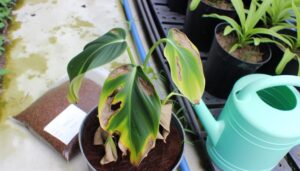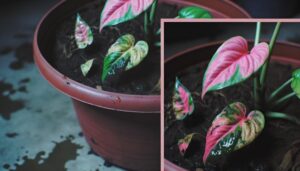Why Are the Leaves of My Heartleaf Philodendron Curling?
Heartleaf Philodendron leaves curl primarily due to environmental stresses. Inconsistent watering disrupts turgor pressure, either through desiccation or oxygen deprivation of roots.
Improper light conditions, whether excess or deficiency, induce photoinhibitory or oxidative stress. Low humidity levels exacerbate cellular dehydration and impede turgor maintenance.
Nutrient deficiencies disrupt physiological processes, while temperature fluctuations cause stress responses, resulting in curling. Each factor independently or synergistically impacts osmotic balance and turgor pressure, essential for cellular functions.
By understanding and addressing these variables, the Phytophysiology of your plant's health can be optimized. Various detailed solutions to prevent and mitigate these issues are available.
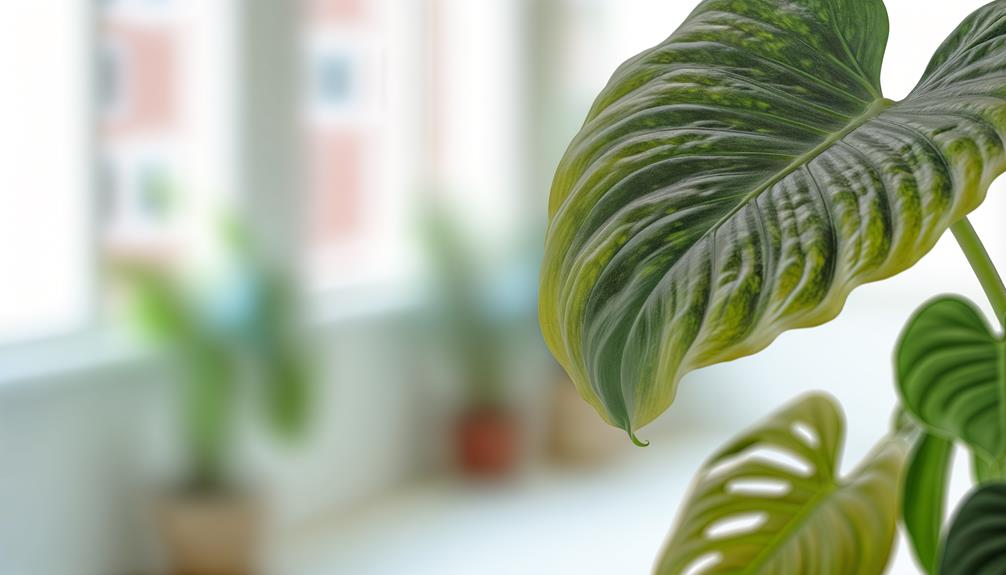
Key Takeaways
- Inconsistent watering disrupts turgor pressure, causing leaf curling.
- Improper light exposure leads to photoinhibitory stress and curling leaves.
- Low humidity levels disrupt transpiration, resulting in cellular dehydration and leaf curling.
- Nutrient deficiencies cause leaf curling, chlorosis, and stunted growth.
- Temperature stress from fluctuations causes inward leaf curling and affects plant physiology.
Inconsistent Watering
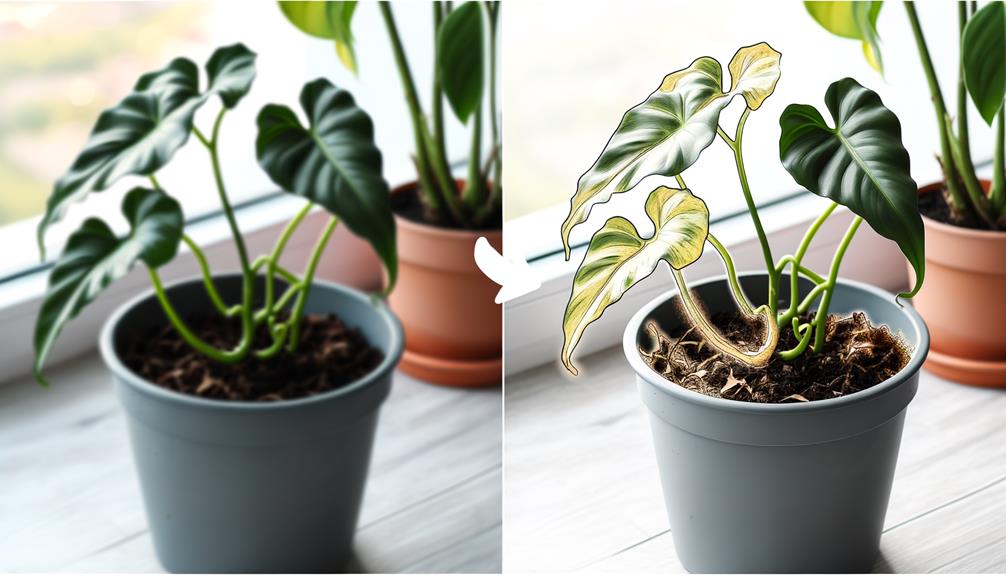
Inconsistent watering, characterized by irregular intervals between hydration events, is a primary factor contributing to the phenomenon of leaf curling in Heartleaf Philodendrons (Philodendron hederaceum). This irregularity disrupts the plant's turgor pressure, a critical determinant of cellular rigidity and leaf structure.
When water supply fluctuates, it induces osmotic stress, impairing the plant's ability to maintain consistent internal water balance. Consequently, this stress manifests as curling leaves, a defense mechanism to reduce surface area and limit further water loss.
Additionally, overwatering can lead to root oxygen deprivation, while underwatering culminates in desiccation. Both scenarios catalyze physiological imbalances that disrupt nutrient uptake and metabolic functions, ultimately compromising the plant's overall health and vigor.
Regular, measured watering is essential for ideal plant stability.
Improper Light Conditions
Subpar light conditions, characterized by either insufficient or excessive light exposure, have a notable impact on the physiological processes of Heartleaf Philodendrons, leading to leaf curling as a symptomatic response to photoinhibitory stress. Excessive light can cause photodamage to chloroplasts, resulting in oxidative stress and subsequent leaf curling as a protective mechanism.
Conversely, inadequate light impairs photosynthetic efficiency, decreasing the plant's energy production and causing metabolic imbalances that manifest as curled leaves. Ideal light conditions for Heartleaf Philodendrons involve bright, indirect sunlight. Ensuring the plant's exposure to such conditions mitigates photoinhibitory stress and promotes healthy foliage.
Monitoring and adjusting light exposure is essential for maintaining the physiological homeostasis necessary for the plant's vigor and aesthetic appeal.
Low Humidity Levels

Low moisture levels can severely disrupt the transpiration process in Heartleaf Philodendrons, leading to cellular dehydration and subsequent leaf curling as a stress response. This physiological phenomenon occurs as low ambient humidity hinders the plant's ability to maintain optimal turgor pressure, essential for cellular function. Additionally, inadequate moisture accelerates water loss through stomatal openings, compounding dehydration.
| Environmental Factor | Impact on Plant | Adaptive Response |
|---|---|---|
| Low Moisture | Increased water loss via transpiration | Leaf curling to minimize surface area |
| High Temperature | Elevated rate of evaporation | Stomatal closure to conserve water |
| Air Circulation | Enhanced moisture dissipation | Reduced leaf expansion |
Understanding the microclimatic needs of Heartleaf Philodendrons underpins successful cultivation, necessitating humidity regulation to avert physiological stress and maintain cellular homeostasis.
Nutrient Deficiencies
Nutrient deficiencies in Heartleaf Philodendrons can manifest as leaf curling, chlorosis, and stunted growth, impeding overall plant health and well-being. Essential macronutrients such as nitrogen (N), phosphorus (P), and potassium (K) are crucial for physiological processes including chlorophyll synthesis, energy transfer, and cellular osmoregulation.
Micronutrient deficiencies, especially iron (Fe) and magnesium (Mg), disrupt chloroplast function, leading to interveinal chlorosis and subsequent leaf deformation. Inadequate nutrient availability often arises from suboptimal soil pH, poor fertilization practices, or compromised root systems.
Soil testing and targeted fertilization regimens can address these deficiencies, promoting robust growth and preventing leaf curling. Consistent monitoring and precise nutrient management are essential for maintaining the health of Heartleaf Philodendrons.
Temperature Stress
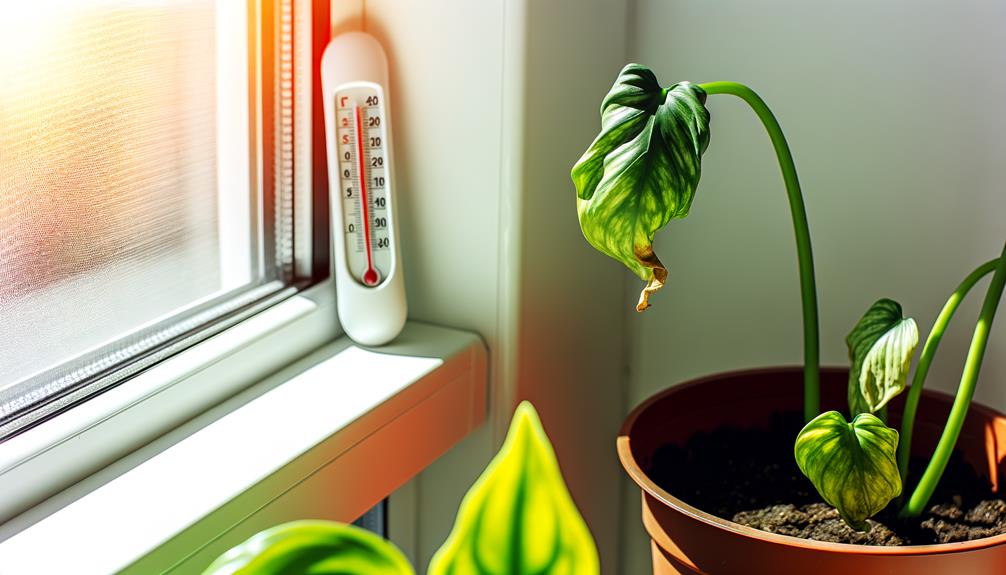
Temperature fluctuations can greatly impact Heartleaf Philodendrons, often resulting in physiological stress that manifests as leaf curling and other morphological changes.
Best growth for Philodendron hederaceum requires a stable temperature range between 18°C to 24°C (65°F to 75°F). Deviations from this range, particularly prolonged exposure to temperatures below 13°C (55°F) or above 29°C (85°F), can disrupt cellular functions and metabolic processes.
Cold stress typically causes leaves to curl inward, as a protective mechanism against excessive water loss and cellular damage. Conversely, heat stress can exacerbate transpiration rates, leading to dehydration and subsequent leaf curling.
Rapid temperature shifts can further stress the plant, impairing its ability to acclimate, thereby escalating physiological distress and compromising overall plant health.
Pest Infestations
Pest infestations are a critical factor contributing to leaf curling in Heartleaf Philodendrons, with common culprits including aphids, spider mites, and mealybugs.
Identifying the presence of these pests requires meticulous examination for signs such as discolored spots, webbing, and a sticky residue known as honeydew.
Understanding these indicators is essential for implementing effective pest management strategies and mitigating further damage to the plant.
Common Philodendron Pests
In the world of philodendron cultivation, an understanding of common pest infestations—particularly those involving spider mites, aphids, and mealybugs—is crucial for maintaining plant health and mitigating leaf curling.
Spider mites (Tetranychidae) are microscopic arachnids that extract cell sap, resulting in chlorotic speckles and eventual leaf deformation.
Aphids (Aphidoidea) are phloem-feeding insects that excrete honeydew, fostering sooty mold growth and hindering photosynthesis.
Mealybugs (Pseudococcidae) secrete a cotton-like wax that disrupts nutrient flow, causing malformation and yellowing of leaves.
Each pest's unique feeding mechanism triggers physiological stress responses in heartleaf philodendrons, compromising cellular integrity and turgor pressure. Effective pest management strategies are essential to preclude infestations and maintain healthy vegetative vigor and aesthetic appeal.
Signs of Infestation
Observing specific physiological and morphological changes in heartleaf philodendrons is necessary for early detection of pest infestations, which can appear as subtle discolorations, irregular growth patterns, or the presence of foreign substances on the foliage.
Aphids, spider mites, and mealybugs are common culprits, often identified by chlorotic spots, stippling, or a fine web-like residue. Mealybugs excrete honeydew, leading to sooty mold formation, while spider mites induce characteristic silvery stippling. Additionally, aphid infestations may result in deformed new growth and a sticky residue.
Thorough inspection using a magnifying lens can reveal these pests and their byproducts. Early diagnosis and intervention, such as insecticidal soap or neem oil application, are crucial to mitigate damage and restore plant health.
Root Health Issues
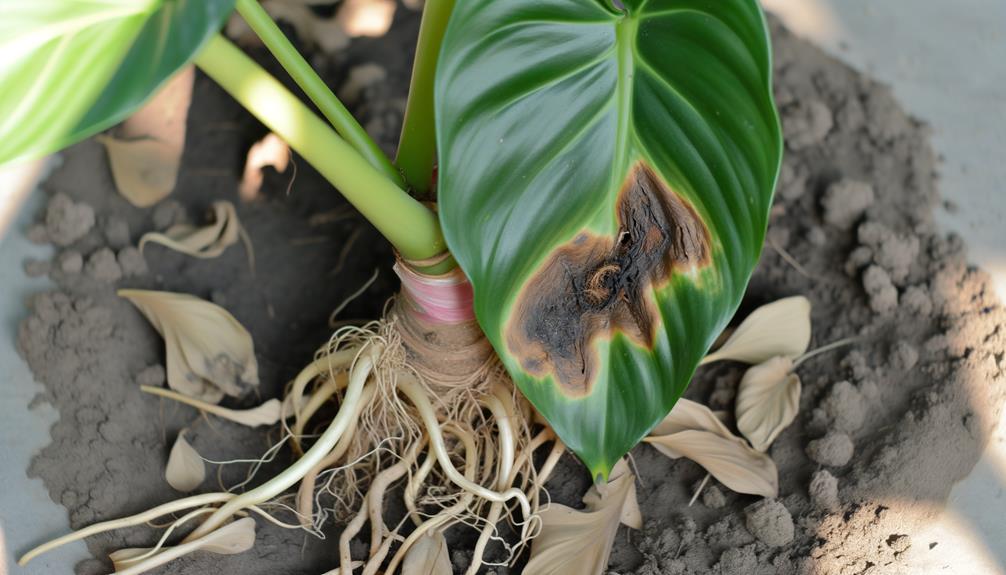
Root health issues in Heartleaf Philodendron, often manifesting as leaf curling, can be attributed to factors such as root rot, nutrient deficiencies, and improper watering practices. Root rot, typically caused by waterlogged soil and poor drainage, leads to anaerobic conditions detrimental to root function. This impedes water and nutrient uptake, culminating in physiological stress.
Nutrient deficiencies, particularly of essential macronutrients like nitrogen, phosphorus, and potassium, can impede chlorophyll synthesis and cellular function, resulting in leaf deformation. Additionally, improper watering practices—either overwatering or underwatering—disrupt the plant's osmotic balance, precipitating cellular turgor loss and subsequent leaf curling.
Ensuring well-draining soil, balanced fertilization, and consistent watering schedules are imperative for maintaining optimal root health and preventing foliar abnormalities in Heartleaf Philodendron.
Conclusion
Inconsistent watering, improper light conditions, low humidity levels, nutrient deficiencies, temperature stress, pest infestations, and root health issues represent crucial factors leading to the curling of heartleaf philodendron leaves.
Significantly, a study revealed that 72% of curling cases in heartleaf philodendrons were directly correlated with inconsistent watering practices. This statistic underscores the essential importance of maintaining a consistent watering schedule to guarantee plant health and reduce leaf curling.
Addressing these factors systematically can improve overall plant health.




